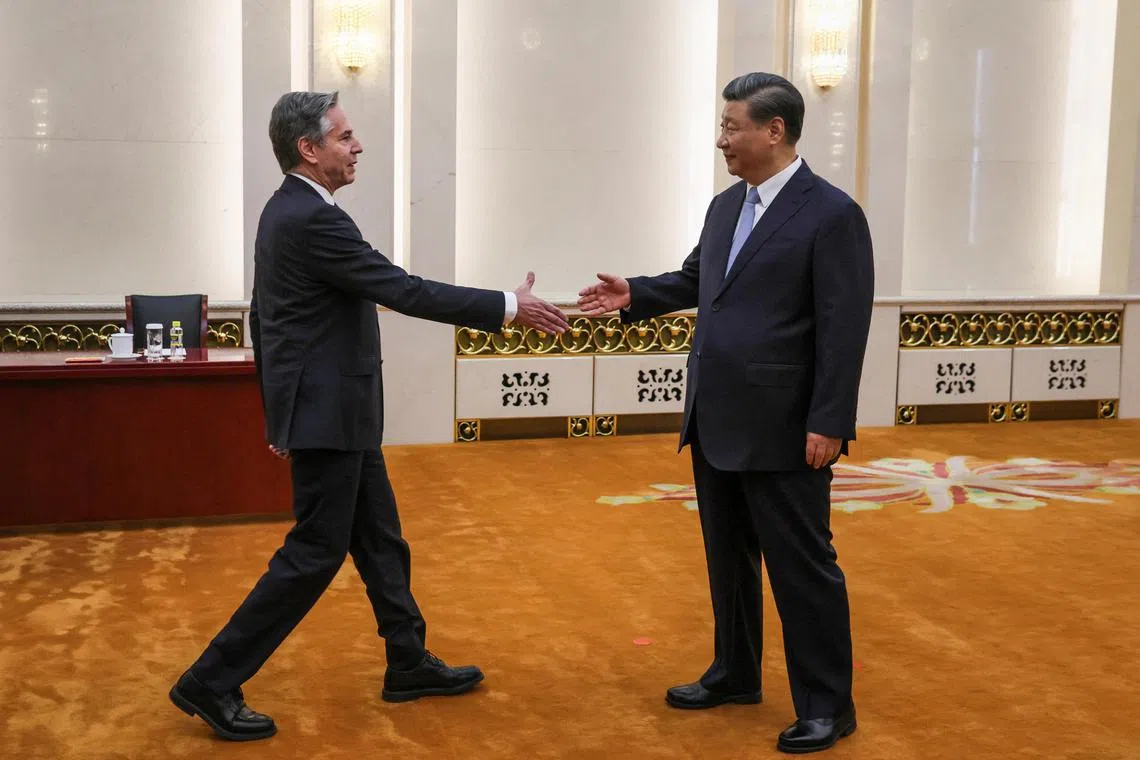Tit-for-tat tariffs: Key moments in US-China trade war
Sign up now: Get ST's newsletters delivered to your inbox

US President Donald Trump and his wife Melania welcoming Chinese President Xi Jinping and his wife Peng Liyuan to the Mar-a-Lago estate in Florida on April 6, 2017.
PHOTO: AFP
Follow topic:
China hiked tariffs on American agriculture and food products, as well as placed 25 US firms on an export and investment blacklist, on March 4.
The move came the same day as an additional 10 per cent duty ordered by US President Donald Trump on China’s exports took effect. This brings to 20 per cent the hike in tariffs
The following are the key moments in the escalating trade spat between the two countries:
2017
March 31: US President Donald Trump signs two trade-related executive orders. While one seeks to assess the reason for the substantial US trade deficit, the other aims at enhancing enforcement efforts against perceived trade violations.
April 6-7: Chinese President Xi Jinping meets Mr Trump for the first time in Florida. The two agree on a 100-day plan to resolve trade disagreements, but are unable to reach a deal by the time this lapses.
Nov 9: Mr Trump salutes Mr Xi while on a state visit to China for leading a country that has left the US “so far behind”. While US$250 billion (S$334.16 billion) worth of business agreements are inked, many of the deals will take years to come to fruition and there is little in the way of tangible gains by the time Mr Trump ends his first term.
2018
Jan 22: Mr Trump announces a 30 per cent tariff on solar cells and modules from all nations, as well as a levy on washing machines. The president said the solar levies would apply for four years, start at 30 per cent and would ultimately fall to 15 per cent.
March 8: Mr Trump imposes tariffs of 25 per cent on steel and 10 per cent on aluminium shipments from all countries.
April 2: Beijing imposes tariffs on 128 American products. While US aluminium, aeroplanes, cars, pork and soya beans draw 25 per cent tariffs, a 15 per cent levy is enforced on fruit, nuts and steel piping.
July 6: A 25 per cent levy kicks in on US$34 billion of Chinese goods. Beijing responds with commensurate tariffs.
Aug 23: A 25 per cent tariff is imposed on a further US$16 billion of goods by the US, and matched by China.
Sept 24: The US begins to apply a 10 per cent tariff on US$200 billion worth of Chinese goods – including computers, furniture, lamps and luggage – which means that roughly half of all Chinese imports have additional tariffs imposed on them by Mr Trump. China responds with its own 10 per cent tariffs on US$60 billion of American goods. Consequently, virtually all American imports are subject to Chinese tariffs.
Dec 1: Both parties announce the postponement of a planned increase in tariffs to negotiate “structural changes” on trade. The US says China will buy a “very substantial” amount of US products.
2019
May 10: Mr Trump hikes the previous tariff of 10 per cent levied on US$200 billion of Chinese goods to 25 per cent, accusing China of reneging on already agreed upon deals.
May 15: Mr Trump declares a national emergency over threats to American technology, with the Commerce Department adding Chinese firm Huawei and its affiliates to an Entity List that restricts access to US technology.
June 1: China adjusts the additional tariffs imposed on US$60 billion of US goods. While it remains as 10 per cent for some imported products, it is hiked to 20 to 25 per cent for others.
June 29: Mr Trump and Mr Xi agree on a 90-day truce in the trade war after meeting on the sidelines of the G-20 summit in Osaka.
Sept 1: The US imposes new 15 per cent tariffs on about US$112 billion of Chinese imports, while Beijing unveils new tariffs of five to 10 per cent targeting US$75 billion of US goods.
Dec 13: The two countries announce that planned new tariffs by both sides will be shelved under a “phase one deal” to resolve the trade dispute. The US also halves the tariffs announced on Sept 1 to 7.5 per cent. China says it will increase purchases of US agricultural products, energy and manufactured goods.
2020
Feb 17-May 14: The US and China both grant tariff exemptions on each other’s goods, but the Covid-19 pandemic makes trade targets harder to reach.
Sept 26: The US imposes restrictions on China’s largest chip-maker,
2021
Jan 20: Mr Trump leaves office. New President Joe Biden says there are no plans to reduce tariffs on China.
2023
June 18-19: Mr Antony Blinken visits China,

Then US Secretary of State Antony Blinken meeting Chinese President Xi Jinping in Beijing on June 19, 2023.
PHOTO: AFP
2024
May 14: The Biden administration unveils steep tariff increases.
Sept 1: China introduces export controls on drones with potential dual military use.
Sept 27: A slew of tariffs announced in May takes effect, with more to be phased in over the next two years.
Dec 3: The US further tightens chip export controls. China retaliates with export curbs on gallium, germanium and antimony.
2025
Jan 20: Mr Trump returns to the White House.
Feb 4: Mr Trump imposes additional tariffs of 10 per cent on Chinese imports. In response,
March 4: Mr Trump raises levies on Chinese goods by another 10 per cent, prompting Beijing to impose a 15 per cent tariff on US chicken, wheat, corn and cotton exports, as well as a 10 per cent tariff on sorghum, soya beans, pork, beef, aquatic products, fruit, vegetables and dairy products. The Chinese measures,


